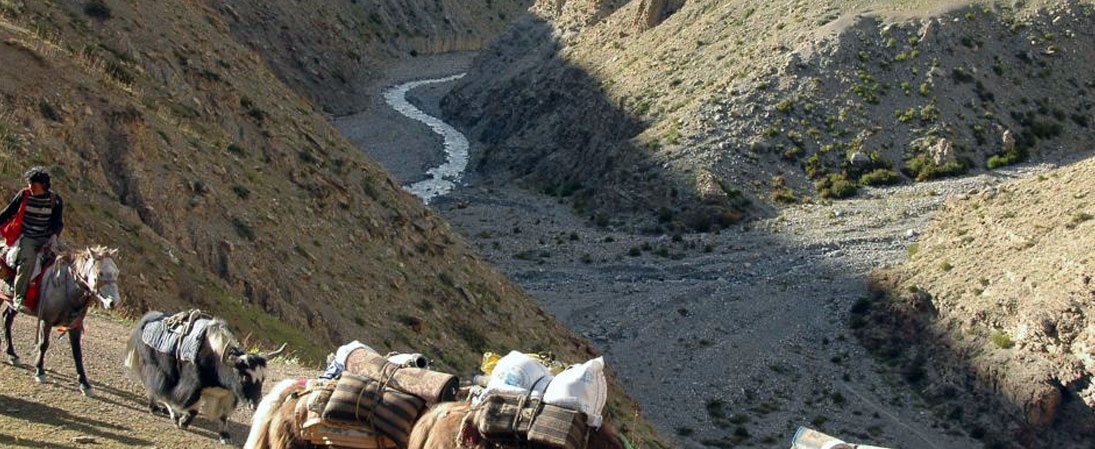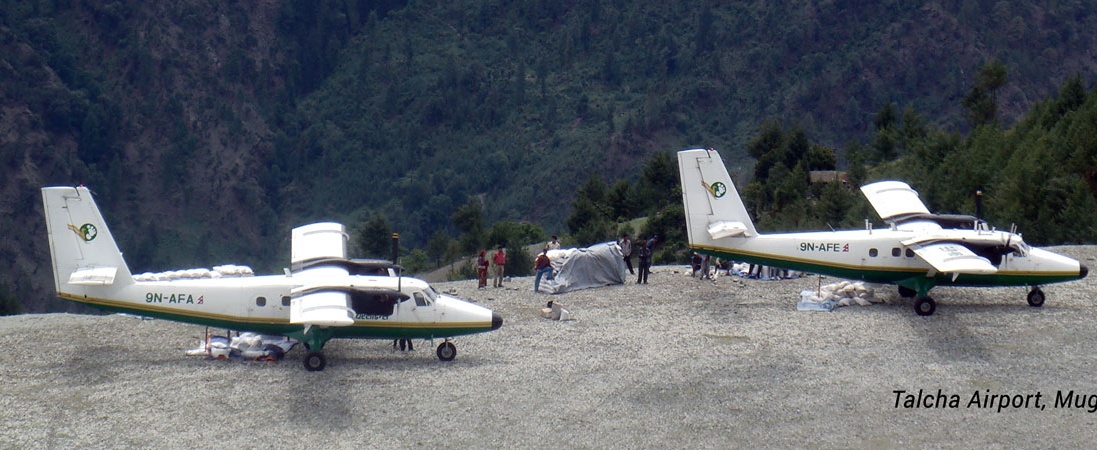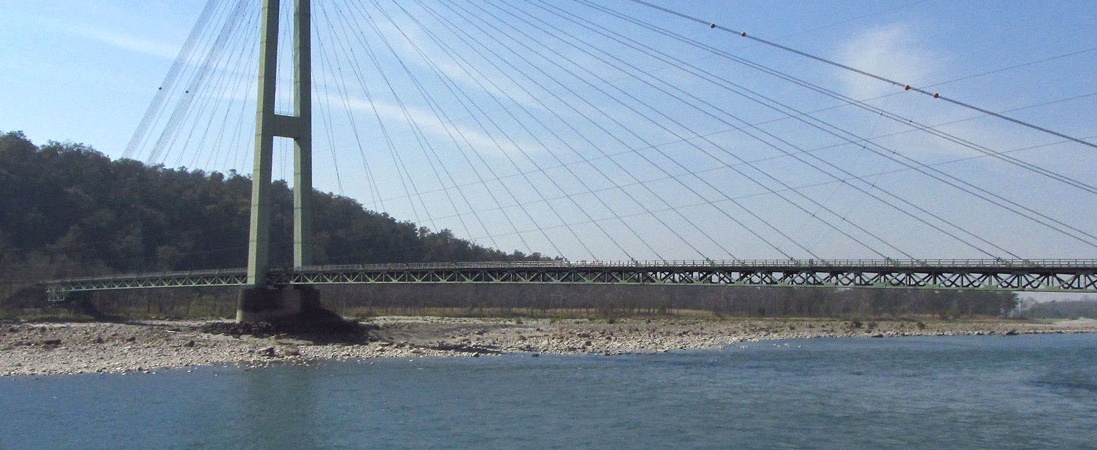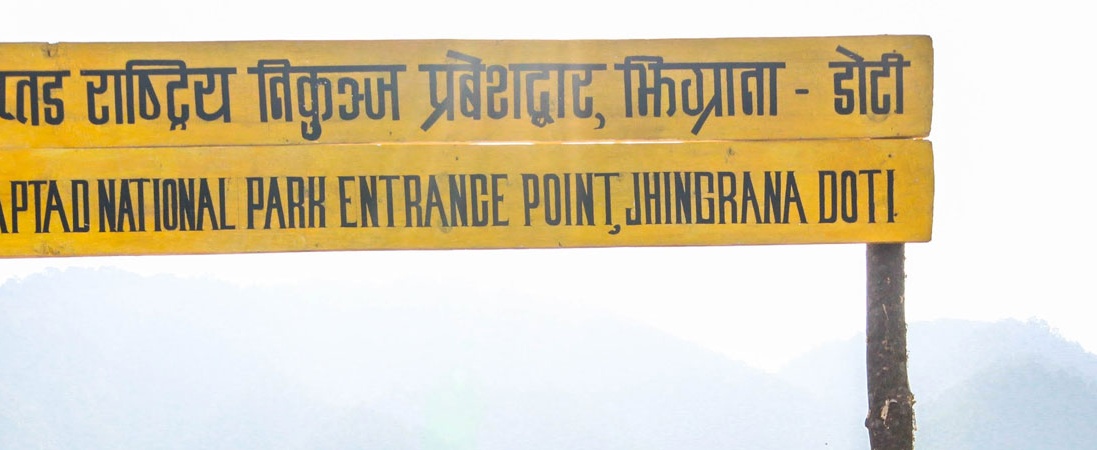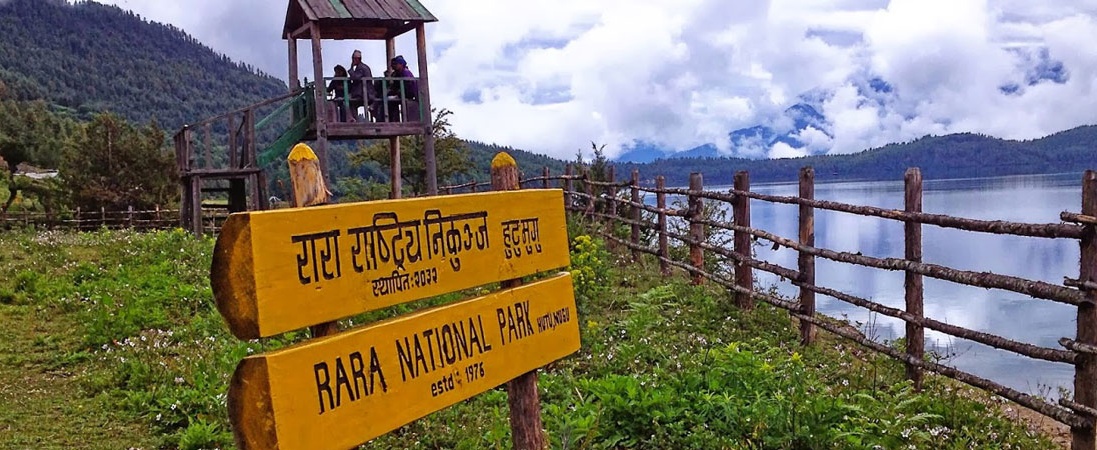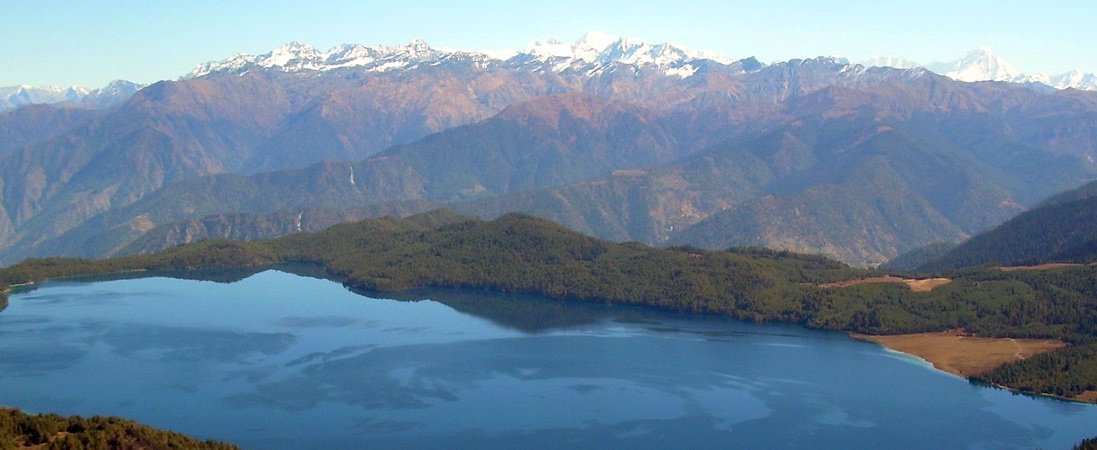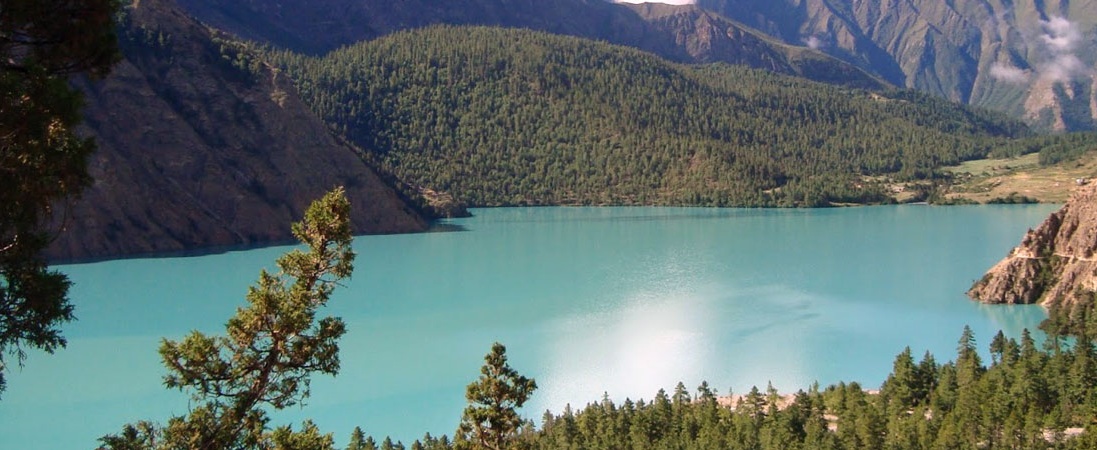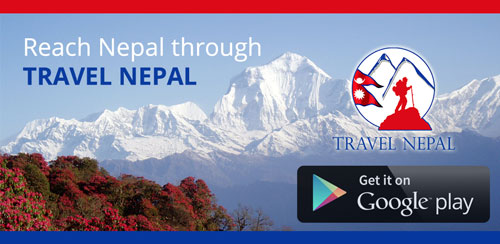Rara Lake has been a popular destination with a hidden treasure route in Western Nepal for trekkers. The glimpses of culture and scenery on the way are quite different from the rest of Nepal. Situated in high altitude, you can find the lake surrounded by Rara National Park with pine, spruce and juniper forest. The views of snowcapped Himalayan Peaks enhance the attraction of trekkers.
Rara Lake (Rara taal) is the biggest lake of Nepal. It lies in Rara Village Development Committee, Mugu District, Karnali Zone in Western Nepal and falls under the Rara National Park. Rara Lake lies at an altitude above 2,990 meters (9,810 ft) above sea level covering an area of 10.8 sq km. The Lake having a length of 5 kilometers and a width of 3 kilometers has a maximum depth of 167 meters (548 ft). Rara Lake being surrounded by Rara National Park has unique flora and fauna importance with rare and vulnerable species. The Park flora consists of 1074 species, of which 16 are endemic to Nepal; the fauna 51 species of mammals and 214 species of birds. The main occupation of the people living around the area is agriculture. People also rear goats and extract medicinal herbs and sell them for their living.
Khaptad is great for spotting wildlife and birds, with 23 species of mammals and 287 types of birds. Mammal species symbolic of the park are leopard, Himalayan black bear, wild dog and musk deer. Bird species include the beautiful Impeyan pheasant (danphe; Nepal’s national bird), Peregrin falcon, the white rumped vulture and many types of partridges, flycatchers, bulbuls, cuckoos and eagles. Go into the wild and venture through thick forests, alpine landscapes and remote mountain villages which have seen very few tourists. This is a perfect trek for the adventurer looking for a real wilderness experience.
Cost Includes:
2 night accommodation in Kathmandu on Bb plan
1 night accommodation in Nepalgunj on Bb plan
1 night accommodation in Dhangadi on Bb plan
All airport transfer and pick up
All entrance fees and permit
Guide and porter
Nepalgunj to Talcha one way air fare
Kathmandu to Nepalgunj one way air fare
Dhangadi to Kathmandu one way air fare
Bajhang to Dhangadi bus fare
Farewell Dinner or Lunch
All government taxes
Day 01: Kathmandu – Arrival
Arrival
at Tribhuwan international Airport. Our representative will be at airport to
receive you and then transfer to hotel. In the evening we will brief about the
trekking itinerary. Overnight at hotel on Bb plan
Day 02: Kathmandu -
Nepalgunj
Early
morning we will visit Swayambhunath also known as Monkey Temple which is one of
the major Buddhist shrine in Nepal. We will then visit Kathmandu Durbar Square
and after lunch take flight to Nepalgunj. Overnight at Nepalgunj
Day 03: Nepalgunj to
Talcha Airport (2200 m)
From
today our trekking begins. After breakfast we will first take flight to Talcha
Airport. After we arrive at Talcha airport we will start trekking. Today we
will walk for 3 to 4 hours and reach Rara Lake. Before dusk we will go for
boating in the pristine Rara Lake.
Day 04: Explore Rara
Lake
Today we will not trek further. We will rest at Rara and
explore surrounding of the lake. A short hike to Murmatop is possibly the best
way to enjoy breathtaking views of Rara – Nepal's largest lake. Along with Rara
Lake, Murmatop also offers magnificent view of Kanjirowa Mountains. Trekkers
are suggested to take packed lunch with them as there are no good hotels and
eateries in Murmatop. The hike, which takes around three to four hours, passes
through a small village. It would be better to start downhill walk early as the
campsite at the banks of Rara Lake offers beautiful views of sunset. In the
evening, trekkers can enjoy moonrise and also see stars reflected in the
pristine waters of Rara Lake. Rara National Park is located in the
north-western Nepal -- south of the Himalayan range. It borders Khamalie, Seri,
Rara, Karkibada, Shreenaagr, and Pina VDCs of Mugu district and Bumramadi
Chaur, Bota Malika, Kanaka Sundari VDCs of Jumla District. Rara Lake is the
main feature of the park. The lake was declared a Ramsar site in 2007. It is
surrounded by the magnificent conifer forests. During winter, bird lovers can
enjoy many migratory birds. In summer, Himalayan flowers surround the lake
creating a colorful landscape. The elevation of the park ranges from 2800m to
4039m. Chuchemera peak (4039m), which forms an excellent backdrop on the
southern side, is the highest point in the national park. The
Day 05: Rara Lake (2990
m) - Sirkot (2041 m) 6 hrs
We head to toward Khaytad following the Khaytad River. Although
our way today is downhill but the walk is pleasing as we see different wild
animals and birds along the trail. After a walk of about an hour, we reach
Majghat (2,374m). There are three teashops along with a health post in Majghat.
After leaving Majghat, the walk is mostly downhill until Murma. There are big
pasturelands in Murma. You can simply lie down in the pastureland and watch
cloud move over your head. We meet locals dressed in their traditional attire.
They speak native language which is somewhat similar to Nepali. We can also see
people smoking homegrown tobacco in their hookah.After about couple of hours,
we reach Jhaudi Khola for lunch. There are big caves around the lunch site. An
hour walk from Jhaudi Khola takes us to Bapani (2,528m). It is a small village
inhabited by Bhramins and Chhetris. There are some teashops and lodges in
Bopani. After passing a village called Jam (2,173m) through Nigalbot (2,410)
and Masane we reach Serkot
Day 06: Sirkot (2041 m)
- Jholunge Pul (1400 m) 7 hrs
After breakfast we will start our trekking. After a walk of
about an hour from Majchaur, we reach Paukipani (1,668m). There are a few
teashops that serve freshwater fish for snacks as well as lunch. After a walk
of about an hour from Paukipani, we reach our lunch site at Bira Bagar
(1,527m). Bira Bagar, as the name suggests, lies on the riverbank. After lunch,
the trek heads toward Jamisera. We cross many suspension bridges and come
across many waterfalls cascading down the hills into the river. We a walk of
about two hours through Ratapani, we reach Ama village. Another half an hour
walk from Ama village takes us to Rega village. From here, we get the first
view of Karnali River. The Khaytad Khola, which we had followed for about three
days, meets Karnali River in this village. After a walk of about an hour along
the Karnali River, we reach our campsite at Jugala. The campsite offers great
view of Karnali River. This is our last camp in Mugu district.
Day 07: Jholunge Pul
(1400 m) - Kolti (1390 m) 7 hrs
Today we cross the Karnali River on a suspension bridge and
enter Bajura district. After a walk of about an hour from Jugala, we reach
Chepi (1,209m). Chepi is a small village on the banks of Karnali River. The
trek then progress towards Kurane Jugala (1119m), which is a walk of about 45
minutes from Chepi.
After a trek of about two hours form Kurane Jugala, we reach
Alange Chaur (1082m). There are a few houses and lodges in Alange Chaur.
Another walk of 45 minutes takes us to our lunch site at Chulighat Badhu. From
Chulighat, you can cross the Karnali River and enter Kalikot district. After
having lunch, we continue our walk along the banks of Karnali River through
Chuli Gadh and Badhu Bagar (1134m). After Badhu Bagar, the trek progresses
along the banks of Kundana River. A two-hour walk from Badhu Bagar through
Badhu Matela (1,240m), Pipal Dali (1.293m) and Raut Badhu, we reach Partola
(1,208m). Kolti is another half hour walk from Partola.
Day 08: Kolti (1390 m)
- Martadi (1591 m) 10 hrs
The trek today is mostly uphill until Pugi Dami. The trail
passes through dense forest offering you the chances of sighting different
wildlife and bird species. We cross many rivulets on log bridges. The trek from
Pugi Dami is downhill until we reach Damkane (2339). There are a few tea shops
in Damkane. After a trek of around three hours from Martadi, we reach our lunch
site at Chuti near Kalika Shool. Chuti is a village inhabited mostly by Dalits.
There are some Brahmins and Chhetris in Chuti. After lunch, we trek downhill
along the Budhi Nandi River to Martdai (1,897). Martadi is the main market area
for four districts -- Bajura, Bajhang, Doti and Accham. The market is big and
has motorable road which is connected to the national road network. It also has
regular power supply. Though there are a few hotels in Martadi, it would be
better to stay in tented camps.
Day 09: Martadi (1591
m) - Dogadi (1490 m) 6 hrs
After leaving Martdai, we reach Goatwall Bata from where we
follow the Bauli River to reach Saleghat (1,362m). A half-hour walk from
Saleghat takes us to Rapak (1308m). Another some hour-long walk from Khudi
takes us to Surkha Bazaar which is also known as Aatichaur. From here, the trek
passes along Dhane Bagar Khola and we reach Buda Bada (1,974m) through Oli
Gaun. An uphill climb for an hour takes us to Lama Gaun (2,023m). After
crossing Dhane Bagar Khola, we reach Chede Daha (2,159m). It is situated on top
of a small hill. An hour walk from Chede Daha talks us to Dogadi village.
Day 10: Dogadi (1490 m)
- Khaptad Campsite (3020 m) 8-9 hrs
After taking breakfast we walk several hours and reach Tham
(2,183m) through Rampur (2,053m). Rampur lies on the border of Bajhang and
Bajura districts. We leave Bajhang and start trek toward Bajura district. The
trail passes through dense forests. Guliya Chaur (2,610m) is the first
destination after we leave Rampur. Guliya Chaur is a pastureland and we feel
that Khaptad is welcoming us. After a walk of about an hour from Guliya Chaur,
we reach Laske Chaur which lies inside Khaptad National Park.
Day 11: Explore Khaptad
National Park and visit Khaptad Baba Ashram
This is the explorer day at Khaptad. As we will be traveling inside the national
park, we will be rewarded with the views of different wildlife and bird species.
After lunch, the trek passes through grasslands for three hours until we reach
the headquarters of the Khaptad National Park. There are excellent campsites
near the park headquarters. The day will
be spent by visiting places in and around the park headquarters like the ashram
of Khaptad Baba and the temples of Shiva and Ganesh, and Nagdhunga and
Kedardhunga in Tribeni.
Day 12: Khaptad
Campsite (3020 m) - Bajhang (Tamail) 9 hrs
We leave forest area after a walk of around an hour from
park headquarters. After walk of around two hours from the park headquarters,
we reach Lekhda (2493m). On reaching on Lamtada we will have lunch and
continues our trail.After lunch, we cross Sunar village following an irrigation
canal. We reach Fulbari after about one and half hours walk from Sunar via
Jimkot (1456m). After a walk of about 3 hours through Jadri Ghat, Aaucheli
Bagar, Tala Bagar, Khati and Khairadi, we reach Tamil (1130m). From Tamil,
regular bus services are available to different parts of the country.
Day 13: Drive to
Dhangadhi (9 hrs)
We board a Dhangadhi-bound bus early in the morning. The bus
takes around 9 hours to reach Dhangadhi – the commercial center of the
far-western region. Dhangadhi has number of good hotels and lodges.
Day 14: Flight
Dhangadhi- Kathmandu
Early
Morning we will take flight from Dhangadi to Kathmandu. After arrival at
Kathmandu you have half day to spend in your own. In the evening we will have
dinner together and share our experience of trekking.
Day 15: Kathmandu Departure
Our
representative will drop you to the International Airport. We wish to see you
again and hope you had wonderful time in Nepal. See you again. End of Our
Service
Cost Excludes:
Visa Fee (free for Indian, Chinese and SAARC nationalities except for Afghans)
Lunch and Dinner in Kathmandu and Nepalgunj
Travel Insurance
Rental charge for sleeping bag and down jacket
Expenses during trek like charging electronic devices, WI-FI, hot shower, toilet paper rolls, mineral water, and other personal items
Tips to guide and porter
Travel Insurance:
About the travel insurance we suggest our guest to take those insurance which covers all emergency case or other travel related injury during your travel in Nepal. However, this is optional and it depends on your opinion. If you are buying any insurance you can buy which covers for a week or only for days you will be in Nepal.
There are many insurance companies, but we suggest you to get World Nomad. They have emergency evacuation even up to 6000m. But before you get it make sure you are covered for such evacuation. For those who already have insurance of other company, make sure if it covers travel insurance in Nepal and especially evacuation up to 6000m. Link for World Nomads is www.worldnomads.com
Cancellation and Refund:
Although it’s rare but sometimes we might cancel trip due to some internal problems, in such a case you will be refunded full amount of package. If guest wish to cancel trip then money will be refunded as following:
Cancelled one month before arrival full refund
Cancelled 15 days before arrival 75% refund of total cost
Cancelled one week before arrival 50% of total cost
Cancelled less than a week 25% refund of total cost
No Show No refund
- Can I travel alone without guide, just with a porter?
Well it’s your choice whether you want a guide or not. But what we suggest you, is to take a guide because there are thousands of solo traveler missing in Nepal. If there is a guide to assist you, you don't have to worry about where to stay for a night; how to find your way, how do you arrange your everyday trip and how do you take care of yourself if there are any bad happenings. Moreover, mountains are not like city area where you will find many to communicate, In the mountain very few speak English, and we remind you not to believe anyone you meet on the way cause there are good and bad people everywhere.
- What age people can trek in the Mountains?
There is no limit in age unless you are below 18 yrs. old. Everyone can trek if their physical strength allows them. If there is kid interested, then he/she must be accompanied by his/her parent. For those above 18 don’t have any restriction. Before you choose any trekking destination consult with your physician and then go for that which you can complete.
- How long is the trekking? How long will be the walking trail?
Trekking depends on the kind of package you choose. There are packages of a week and even of 3 weeks and more. When you are trekking average hour you will trek is four to six hours, in some cases 7 hours a day, which will be minimum of 7km and maximum 15 km of walking in a day.
- Is it compulsory to have previous trekking history?
No, if this is your first time then it's OK. Not all the trekkers have previous experience. There are many beginners who do well than those experienced ones. Before you come to Nepal indulge yourself in some walking or stamina building sports, so that it becomes easier for you to even walk for 6 hours a day.
- What things do I need to prepare before coming to Nepal?
Documents:
You will require documents like passport, color copies of passport, passport size photo graphs, if you are below 18 and travelling with friends, you will require a written document by your parents (travel agreement), if you are going under medication, written prescription by doctor is required. Besides these, if there are any other compulsory documents we will inform you during booking. For any other information you can check our travel essentials where information about Customs, Visa and Travel tips is given.
Equipment:
You will require that equipment which is listed in Equipment list. Please check there. You are free to carry other item if you need even if not mentioned in the list.
Travel Insurance:
Apart above mentioned, most important thing you will require is Travel insurance. As, we've said it's optional but it’s better if you have one. There are many insurance companies, but we suggest you to get World Nomad. They have emergency evacuation even up to 6000m. But before you get it make sure you are covered for such evacuation. For those who already have insurance of other company, make sure if it covers travel insurance in Nepal and especially evacuation up to 6000m. Link for World Nomads is www.worldnomads.com
- What permits are required and who will arrange it for us?
For every trekking, either short or long you will require permits. For all trekking region you will require TIMS (Trekker's Information Management System). We will get it for you and you should prepare a photograph for it. Another is National Park permit. For every trekking region which falls under national park or conservation area, you will require permit. Another is for trekking in restricted area like Upper Mustang and Upper Dolpo where you will need a special permit which will be given for a week or limited days. If permit gets expired you will have to pay extra per day.
- When should I travel to Nepal?
Nepal has two tourist seasons one is spring and other is autumn. Spring season is February to May. Autumn is late August till mid-November. Summer in Nepal receives heavy rainfall which makes trails slippery and dangerous. There are many avalanches in Mountain during this time, so we suggest not to travel during summer. Another is winter; winter in mountains is too cold. Temperature drop to -20°C. There is snowfall and due to bad weather flights even get cancelled for 1 week. So, it’s better not to travel in winter as well.
- What is Altitude sickness? What is acclimatization?
When you are trekking in mountain, as you go upwards oxygen in air decreases. Sometimes you might feel headache, vomiting and nausea followed by dizziness. So when you see these symptoms, you might be suffering from Altitude sickness. So, if you have any such symptoms immediately tell your guide. To avoid altitude sickness you will have to take rest and let your body adjust to the surrounding which is called Acclimatization. If you feel too difficult even after acclimatization the best option is to descend rather than to wait for any rescue.
- What to do in emergency cases and injuries?
If there is small injury or accident, then our guide will provide you with first aid. All our guides have received first aid training so this will not be a serious matter. However, your safety comes first. If there is any big accident, then we will take you to nearby hospital. If there is case of emergency than we will immediately contact your insurance and you will be rescued by a helicopter.
- What do I need to pack?
This basically depends on which season of year you are traveling. If it is autumn then you should keep in mind that winter is approaching, so it will be cool. If it is spring then you should be aware it gets warmer day by day. Generally in all kind of trekking you will require, a down jacket, a warm fleece jacket, thermal underwear, trekking pants and shorts, trekking boots, a thermal sleeping bag, backpack, and camera. Carry light and few items as much as possible. Just make sure you have all the necessary equipment and clothes. Too much overpacking will trouble you in the end. If you are under medication, carry your medicine. If you want to bring something with yourself for the trek but you don't have it right now, we suggest you not to buy such things. Almost all the necessary gears can be easily bought or be rented at shops in Kathmandu.
- Is there any arrangement for single travelers?
Whether you are single or traveling with group, a long as you are traveling with Nep Travels, you will be given a guide. If you are single and want a porter, you have to pay extra $11 per day for a porter. If there is more than one person then, one porter will be provided automatically. Generally, we have porter in 2:1 ratio; two trekkers will have one porter.
- How much weight will porter carry?
In an average porter will carry 5kg to 15kg. We recommend you to carry bag of 10-15kg (max.) weight. Try to carry few items as possible. You have to carry your important stuffs by yourself like camera, passport, small day bag and other food (chocolates, energy drinks). Rest other will be carried by porter. So you will have two bags during trekking, one carried by porter another carried by yourself.
- What communication options exist while trekking?
Don't forget you are trekking in the remote areas. However, access to mobile and internet is expanding so you can communicate using local mobile card and internet. Many routes offer local VHF phones, while more remote trails, a satellite phone is the only option. Connections are interrupted frequently but it's still OK considering place you are traveling.
- How will the case of incomplete trip be handled?
There is rare chance of incomplete trip. However, if there is such incident then we are sorry and please understand we cannot refund you money that you've paid. All the arrangements are done before your arrival, so we have to pay in advance for hotels, lodges, guide and porter. Permit and TIMS once used cannot be refund, so we will not be able to refund your money. If due to climate reasons or our technical problem you cannot start trek, then you can change trekking package and switch to another one.
- What about tips to guide and porter?
Well, tips are optional. If you are happy with service then you can tip as much as you want. Many guests avoid tipping to guide and porter. However, guide and porter work hard to make your trip successful, so they expect something from you. So, generally we suggest $80 as tip to porter and guide. Then they will divide within each other. If you are in group the, collect $80 per person then divide equally to guide and porter. We fairly said you the idea of tipping, if you have any other questions related to tipping, please mention them during booking.
- What sort of accommodation and food will be in mountain?
Everything in the mountain will be basic. You will stay in tea houses which is lodges and small hotels in the trekking routes. Accommodation will be in twin sharing basis. You will be given three meals and a drink (coffee, hot chocolate, tea) a day. As you go up wards, you will be served simple food. We suggest you to order vegetarian food cause meat in mountains are not fresh and you may easily suffer from Diarrhea. Mineral water in mountain is expensive than city and it gets more expensive as you go upward. You can buy water purifying pills and drink water which is served in local hotel and lodges by purifying yourself.
All Inclusive Price.
$ 2800 USD
Estimated Time
15 days
*CONTACT US FOR DEPARTURE DATE
Customize this trip.
- Number of members ? No problem.
- We can customize as per your need.
- We will help you to make this trip fit in your budget.
- Contact us for more information and enquiry.
Trip Facts
- Duration:15 Days
- Highest access:3020
- Group Size:2- above
- Best Season:Spring, Autumn
- Accommodation:Tea Houses and Camping
- Difficulty level:



 (Hard)
(Hard)





